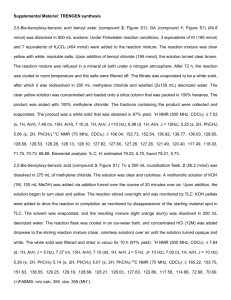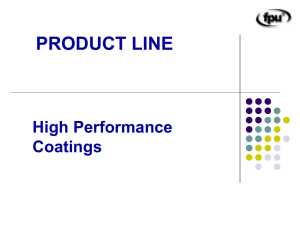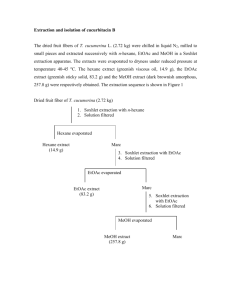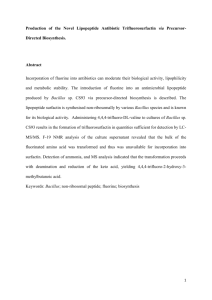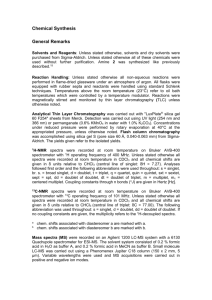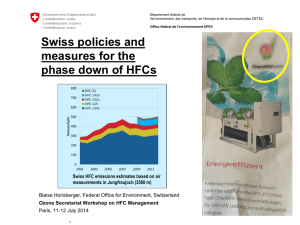Novel_fluorinated_lipopeptides_from_Bacillus_sp_FINAL
advertisement
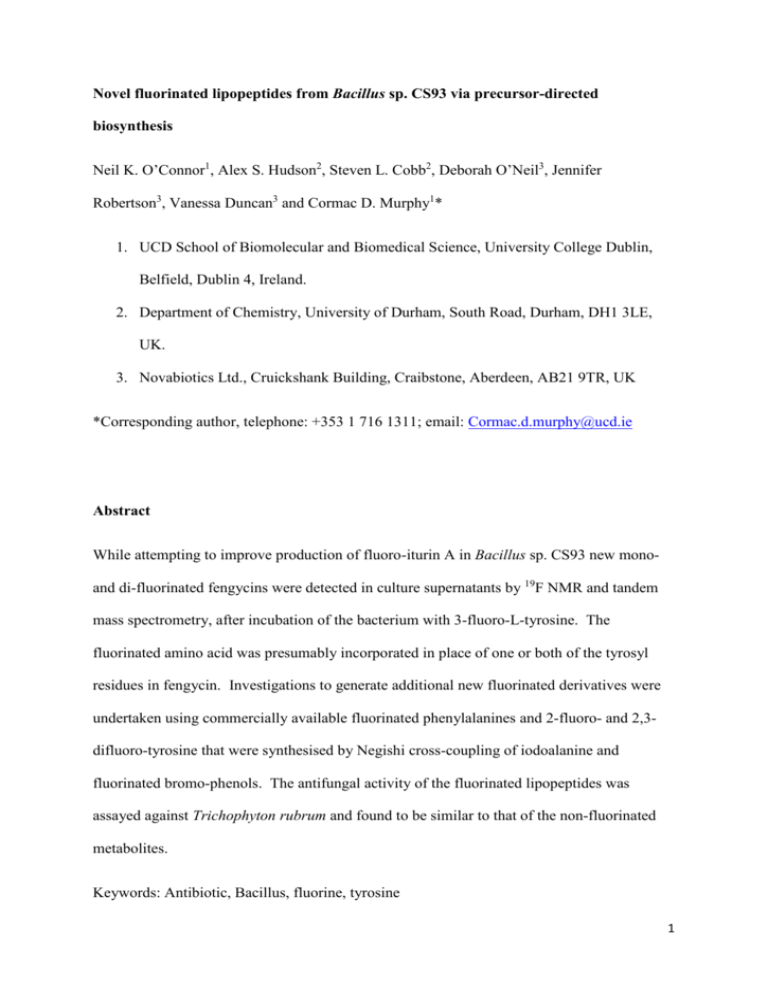
Novel fluorinated lipopeptides from Bacillus sp. CS93 via precursor-directed biosynthesis Neil K. O’Connor1, Alex S. Hudson2, Steven L. Cobb2, Deborah O’Neil3, Jennifer Robertson3, Vanessa Duncan3 and Cormac D. Murphy1* 1. UCD School of Biomolecular and Biomedical Science, University College Dublin, Belfield, Dublin 4, Ireland. 2. Department of Chemistry, University of Durham, South Road, Durham, DH1 3LE, UK. 3. Novabiotics Ltd., Cruickshank Building, Craibstone, Aberdeen, AB21 9TR, UK *Corresponding author, telephone: +353 1 716 1311; email: Cormac.d.murphy@ucd.ie Abstract While attempting to improve production of fluoro-iturin A in Bacillus sp. CS93 new monoand di-fluorinated fengycins were detected in culture supernatants by 19F NMR and tandem mass spectrometry, after incubation of the bacterium with 3-fluoro-L-tyrosine. The fluorinated amino acid was presumably incorporated in place of one or both of the tyrosyl residues in fengycin. Investigations to generate additional new fluorinated derivatives were undertaken using commercially available fluorinated phenylalanines and 2-fluoro- and 2,3difluoro-tyrosine that were synthesised by Negishi cross-coupling of iodoalanine and fluorinated bromo-phenols. The antifungal activity of the fluorinated lipopeptides was assayed against Trichophyton rubrum and found to be similar to that of the non-fluorinated metabolites. Keywords: Antibiotic, Bacillus, fluorine, tyrosine 1 Introduction Several Bacillus spp. produce the antimicrobial lipopeptides surfactin, iturin and fengycin (Chen et al. 2008). These compounds are produced via non-ribosomal peptide synthases and are composed of a cyclised peptide and an alkyl chain of varying lengths, as illustrated in Figure 1 (Koumoutsi et al. 2004). The antimicrobial activities of the lipopeptides are of considerable interest, and the producing bacteria are used as environmentally-friendly biocontrol agents to inhibit plant pathogens, e.g. Serenade from Agraquest and FZB24®TB from ABiTEP GmbH are both formulations containing lipopeptide-producing strains of B. subtilis. The general mechanism for the antimicrobial activity of the different lipopeptides is permeabilisation of cell membrane, particularly of fungi; however, the interactions are somewhat different for each peptide type (Bonmatin et al. 2003). Iturin A interacts with sterols in fungal membranes via the phenolic OH of tyrosine, surfactin behaves as a powerful surfactant and fengycins inhibit phospholipase and forms pores in membranes, resulting in leakage (Tao et al. 2011). Bacillus sp. CS93 was originally isolated from pozol (Ray et al. 2000), a Mayan fermented product that was consumed as a food and used as a treatment for intestinal complaints and skin infections. The strain is known to produce the dipeptides bacilysin and chlorotetaine, plus the lipopeptides iturin A, surfactin and fengycin (Phister et al. 2004; Moran et al. 2010); it is likely that the antimicrobial properties of these compounds are responsible in part for the curative properties of pozol. The substrate flexibility of the biosynthetic machinery involved in lipopeptide production has enabled precursor directed incorporation of 3-fluorotyrosine and 4,4,4-trifluorovaline into iturin A and surfactin, respectively (Moran et al. 2009; O'Connor et al. 2012). Approximately 20 % of currently available pharmaceuticals and 30 % of agrochemicals contain fluorine, which can alter 2 compounds’ properties such as lipophilicity and metabolic stability, thereby improving their biological activity (Murphy et al. 2009). Incorporation of fluorine into lipopeptides might have an influence on biological activity, for example, the hydroxyl group of the tyrosyl residue in iturin A plays an important role in binding to fungal membranes (Volpon et al. 1999), and the acidity of the group will be altered with the presence of fluorine. Additionally, fluorinated compounds might be useful as probes for fluorine-19 NMR studies of membrane interactions and receptor binding (Cobb and Murphy 2009). In this paper the incorporation of various fluorinated amino acids into fengycin and iturin, and an assessment of some of their biological properties are reported. CH 3(CH 2)12 Fengycin Iturin A Fig. 1. Structures of C-16 fengycin and C-14 iturin A. 3 Results and Discussion In our previous study (Moran et al. 2009) we demonstrated that fluorinated iturin had antifungal activity, but the limited amount of material available at the time prevented any quantitative assessment. So that more rigorous evaluation of the biological properties of fluorinated iturin A could be conducted, attempts were made to up-scale production of this metabolite by modifying the growth conditions of the producing strain (Bacillus sp. CS93) using a growth medium optimised for lipopeptide production (Ahimou et al. 2000) and increasing the culture volume by employing multiple culture vessels. Fluorinated iturins were detectable in crude methanolic extracts by electrospray mass spectrometry (Table 1), and C-14 fluoroiturin was detected in the highest concentration (0.5 mg L-1) by HPLC. Purification of this analogue was achieved by semi-preparative HPLC generating a 1:1 iturin A:fluoro-iturin mixture, but total separation was not possible using this method. Table 1. Ions from ESI-MS analysis of lipopeptides produced by Bacillus sp. CS93 cultures incubated with 3-fluoro-L-tyrosine. Chain length C-14 Iturin A C-15 Iturin A C-16 Iturin A Chain length C-14 Fengycin A C-15 Fengycin A C-16 Fengycin A C-17 Fengycin A C-18 Fengycin A [M+Na+] 1065.58 1079.61 1093.17 [M+H+] 1435.95 1449.95 1463.90 1477.84 1491.85 [F+M+Na+] 1083.42 1097.60 1111.18 [F+M+H+] 1453.84 1467.72 1481.81 1495.75 1509.76 [2F+M+Na+] N/A N/A N/A [2F+M+H+] 1471.68 1485.83 1499.67 1513.83 1527.86 Attempts were also made to broaden the diversity of the fluorinated iturins produced by Bacillus sp. CS93 by conducting feeding experiments with other fluorinated phenylalanines and tyrosines. No incorporation was detected with 2-fluorophenylalanine or 3,4- and 3,5difluorophenylalanine; HR-MS analysis of HPLC-purified lipopeptide from cultures fed with 4 4-fluoro-L-phenylalanine revealed an ion m/z 1081.5422 that was not present in cultures grown in the absence of the amino acid and has the expected mass of a sodiated C-15 iturin A analogue in which tyrosine has been replaced with fluorophenylalanine (1081.5458). Furthermore, a new resonance was also observed by 19F-NMR (F -118.8 ppm), approximately 2 ppm upfield from that of the precursor (not shown). Therefore, it is likely that a very small incorporation of 4-fluorophenylalanine had occurred in place of tyrosine. However, not enough was formed to warrant any attempt at further purification. The known fluorinated amino acids 2-fluorotyrosine 7 (Kim et al. 1998) and 2,3-difluoro-tyrosine 8 (Kim et al. 1998) were synthesised using a Negishi cross-coupling of iodoalanine and fluorinated bromo-phenols as the key step (Scheme 1). The Negishi cross-coupling conditions used to prepare compounds 5 and 6 have been previously shown to preserve the stereochemical integrity of the alpha-carbon (Colgin et al, 2011). However, no incorporation into iturin A was detected when these compounds were fed to Bacillus sp. CS93, suggesting that either these precursors are not substrates for the adenylation reaction in place of tyrosine, or their incorporation into the growing peptide results in inhibition of downstream reactions. 5 ii) i) iii) 1 L-serine v) vi) iv) 2 3, R1=F, R2=H 4, R1, R2=F 5, R1=F, R2=H 6, R1, R2=F 7, R1=F, R2=H 8, R1, R2=F Scheme 1 i H2O, THF, NaOH, di-tert-butyl dicarbonate ii DMF, K2CO3, benzyl bromide iii DCM, PPh3, imidazole, I2 iv DMF, Zn, I2, Pd2(dba)3, SPhos v MeOH, HCl vi EtOAc, Pd, H2 In the extracts from cultures that had been fed with 3-fluoro-L-tyrosine resonances were observed by 19F NMR that had not previously been seen (Fig 2). These were initially thought to be gratuitous biotransformation products unrelated to lipopeptide biosynthesis, but closer inspection of the ESI-MS spectra indicated that the precursor is being incorporated into fengycin, a lipopeptide also known to be produced by this strain (Moran et al. 2010). Ions that were 18 and 36 Daltons heavier than the expected masses of C14-C17 fengycins were observed (Table 1) and as fengycin contains two tyrosyl residues (residues 3 and 9, Figure 1), both singly and doubly fluorinated fengycin can conceivably be produced. To enable further characterisation, 4 mg of putative C-16 and 1 mg of C-17 monofluorofengycin (m/z 1482.05, 1495.75, respectively) were purified from 2 L of culture by a combination of acid precipitation, solid phase extraction and semi-preparative HPLC. 19 F NMR analysis of the C- 16 analogue revealed two resonances (Fig 2), suggesting fluorotyrosine incorporation into either of the two positions, although not to the same degree, since the resonance δ -143.3 ppm 6 is greater than at δ -131 ppm (4:1 ratio). The presumed C-16 metabolites were subjected to analysis by tandem MS (Fig 3A) and the fragmentation compared with that of nonfluorinated C-16 fengycin (Wang et al. 2007; Li et al. 2012). Key fragment ions were detected that were 18 mass units heavier than the corresponding fragments of natural C-16 fengycin. Loss of water is observed yielding m/z 1464 and the product ion m/z 1227 results from the loss of the acyl chain; m/z 1098 and 984 correspond to the neutral loss of [acyl chain-Glu] and [acyl chain-Glu-Orn], respectively (Fig 3B). Whilst these fragments are consistent with the incorporation of fluorotyrosine, they do not indicate the location of the residue. Wang et al. (2007) detected a major ion m/z 966 in the CID spectrum of fengycin, and deduced it to be Pro-Gln-Tyr-Ile-Tyr-Thr-Glu-Ala (Fig 3C). The fluorinated equivalent m/z 984 is apparent in Fig 3A together with smaller ions, notably m/z 389, which was also observed in the CID of non-fluorinated C-16 fengycin, and is Pro-Gln-Tyr. Thus, it can be inferred that the fluorotyrosine is predominantly incorporated in position 3 of the lipopeptide. Whilst ion m/z 407 is present, arising from fluorotyrosine in position 9, its abundance relative to that of m/z 389 is much lower and reveals that the minor resonance δ -131 ppm observed by 19F NMR is most likely due to the small quantities of this fluorofengycin isomer. These data strongly suggest that fluorotyrosine is preferentially incorporated into position 3 of the fengycin peptide. Interestingly, the overall degree of incorporation is greater than that into iturin A (Fig 2); the stereochemistries of the tyrosine residue of iturin A and position 9 of fengycin are both D, as a consequence of epimerisation reactions after incorporation, whereas residue 3 of fengycin retains the L-configuration. Therefore, the relatively poor incorporation of fluorotyrosine into iturin A or residue 9 of fengycin may be influenced by the epimerisation step rather than adenylation. 1H NMR analysis of the natural fengycin revealed 2H tyrosine doublets (δH 7.14, d, J = 8.4 Hz; δH 6.70, d, J = 8.4 Hz) for one of the tyrosine residues and another doublet (δH 7.07, d, J = 8.4 Hz) plus a broad singlet (7.20 ppm) for the 7 other tyrosine residue. In the 1H NMR spectrum of the fluorofengycin, the doublets were replaced with multiplets at 7.07, 7.03, 6.90, 6.82 and 6.67 ppm, indicative of the presence of two different fluorofengycins in which one or the other tyrosine had been substituted with fluorotyrosine. ESI-MS also detected a faint ion at m/z 1427.90 in culture supernatants after feeding Bacillus sp. CS93 with 2,3-difluoro-L-tyrosine 8, suggesting the production of trace amounts of difluorofengycin. The same ion was not detected in control experiments in which the fluorinated amino acid was incubated in the absence of bacterium. Fig. 2. 19 F NMR spectra of lipopeptide extract from Bacillus sp CS93 after incubation with 3-fluorotyrosine (bottom) and purified C-16 fluorofengycin (top). The starting material, 3fluorotyrosine, and fluorinated iturin can be seen in the crude extract at δF -142.7 and -142.95 ppm, respectively. The purified fluorofengycin has two resonances (δF -131.3, -143.3) indicating that 3-fluorotyrosine is incorporated in place of one or other of the tyrosine residues in the lipopeptide. 8 Antifungal testing The biological activity of the natural and fluorinated lipopeptides were compared by measuring the minimum inhibitory concentration (MIC) with the fungus Trichophyton rubrum using the broth dilution method. Commercially available iturin A (Sigma) had an MIC of 64 µg/mL, whereas purified C-14 iturin A and a mixture of C-14 iturin/fluoroiturin A had an MIC of 32 µg/mL. This difference might be accounted for by the presence of a mixture of different fatty acyl chain lengths in the commercially available material (C-14, C15 and C-16) and, by extension, suggests that C-14 iturin A is more potent that those derivatives with longer chain lengths. Fengycin (C-16 and C-17) and its fluorinated derivatives did not inhibit T. rubrum at the highest concentrations employed for the assay (64 µg/mL) and owing to the limited amount of material available, no additional concentrations were tested. Conclusions Feeding 3-fluoro-L-tyrosine to cultures of Bacillus sp. CS93 resulted in the biosynthesis of fluorinated iturins and fengycins. The fluorinated amino acid was incorporated in place of the tyrosine residue in iturin and either tyrosyl residue in fengycin. 2-Fluorotyrosine was not incorporated into either lipopeptide, but trace amounts of 4-fluorophenylalanine and 2,3difluorotyrosine were incorporated into iturin A and fengycin, respectively. Bioassay of the anti-fungal properties of fluoro-iturin A and mono-fluorofengycin indicated that the presence of fluorine did not dramatically alter potency. Nevertheless, the fluorinated lipopeptides have potential application for probing the interaction with membranes via 19F NMR. 9 Fig 3. Tandem MS of fluorinated C-16 fengycin (A) and key ions formed upon fragmentation of the lipopeptide (B) and the lactone portion (C) ions compared with the naturally produced analogue. [For tandem MS the ion selected for fragmentation was m/z = 1482.05 and ion current used was 2.79 x 103]. 10 Experimental General methods NMR spectra were collected using either a Bruker Avance 400 MHz, a Varian Inova 400 MHz or a Varian VNMRS 600 MHz spectrometer , multiplicities; s = singlet, d = doublet, dd = doublet of doublets, dt, doublet of triplets, m = multiplet, t = triplet, q = quartet, bd = broad doublet, bs = broad singlet, app. s = apparent singlet, app. d = apparent doublet, app. t = apparent triplet. Chemical shifts are reported in ppm and are referenced to residual solvent peaks; J couplings are measured in Hertz (Hz). All reported yields refer to the isolated yield and the product purity was estimated to be >95% by 1H NMR. Electrospray-ionisation mass spectrometry was conducted using a Waters Q-tof Premier coupled to a Waters Alliance 2695 solvent delivery system. Optical rotations were measured with a Jasco P-1020 polarimeter. Bacillus sp. CS93 was obtained from the Microbial Genomics and Bioprocessing Research Unit, National Centre for Agricultural Utilization Research, Peoria, IL. All media components were purchased from Sigma-Aldrich. 3-Fluoro-L-tyrosine was purchased from Fluorochem, Derbyshire, UK. Fluoro-phenylalanines were supplied by High Force Research Limited, Durham, UK. Feeding studies Bacillus sp. CS93 was grown for 72 h in 250mL Erlenmeyer flasks containing a medium optimal for lipopeptide production consisting of (g L-1) peptone (30), sucrose (20), yeast extract (7), KH2PO4 (1.9), MnSO4.H2O (0.0036) MgSO4 (0.45), C6H8O7 (0.01), CuSO4 (1 10-6), FeCl.6H2O (5 10-6), Na2MoO4 (4 10-6), KI (2 10-6), ZnSO4.7H2O (1.4 10-4), H3BO3 (1 10-5), as described by Ahimou et al.(2000) Fluorinated tyrosines (2 mM) were introduced to the cultures after 24 h incubation. For up-scale experiments, 20 Erlenmeyer 11 flasks were employed. To extract the lipopeptides the culture supernatants were harvested by centrifugation, acidified to pH 2 and the resulting precipitate was extracted with methanol. The crude lipopeptide fraction was further purified by elution from a Hypersep C-18 solidphase extraction column (Supelco) using a step-wise water:methanol gradient and semipreparative HPLC on a Varian Prostar system. Iturins were eluted from a SigmaAcentis C-18 column (10 x 150 mm 5 μm) with 35 % MeCN: water (3.6 mL min-1) and fengycins were eluted from an Agilent Zorbax StableBond column (9 x 150 mm 5 μm) column with 40 % MeCN: water (4 mL min-1). Antimicrobial assay Antifungal susceptibility testing to determine the Minimum Inhibitory Concentration (MIC) was conducted using the broth micro-dilution procedure in 96-well plates, according to guidelines set out by CLSI (2008). The MIC at which no growth was observed (MIC) was determined by changes in absorbance (530 nm) for up to seven days for T. rubrum. All experiments were conducted in triplicate on triplicate samples. Fluorotyrosine synthesis Boc-Ser-OBn (1) L-serine (0.67 g, 1.00 eq) was stirred at room temperature in THF (20 mL), H2O (10mL). The solution was treated first with 10% aqueous NaOH (20 mL) and then boc anhydride (di-tertbutyl dicarbonate) (1.13 g, 1.20 eq). The reaction mixture was left to stir at room temperature for 20 h and THF was removed under reduced pressure. The resulting solution was acidified to pH 2 with 10% citric acid and extracted with ethyl acetate (EtOAc) (3 x 50 mL). The combined organic extracts were washed with H2O and dried over MgSO4. Filtration and evaporation yielded the Boc-protected amino acid as a clear oil. Boc-Ser-OH (1.53 g, 1.00 12 eq), benzyl bromide (0.98 mL, 1.10 eq) and K2CO3 (1.13 g, 1.10 eq) were dissolved in DMF (30 mL) and stirred for 20 h at room temperature. H2O (150 mL) was added to the reaction mixture and the aqueous phase was extracted with ether (3 x 60 mL). The combined organic extracts were washed with brine (2 x 50mL), dried over MgSO4 and evaporated under reduced pressure to yield 1 as white powder (1.71 g, 78%). δH (400 MHz; CDCl3) 1.44 (9H, s, tBu), 3.95 (2H, m, β-CH2), 4.43 (1H, m, α-CH), 5.21 (2H, m, CH2Ar), 5.48 (1H, m, NH) 7.29 - 7.41 (5H, m, ArH); m/z (ESI+) 318.1 (M + Na+) Data obtained is consistent with that given in the literature (Friscourt et al. 2012). Boc-AlaI-OBn (2) 1 (0.70 g, 1.00 eq), I2 (0.60 g. 1.00 eq), imidazole (0.16 g, 1.00 eq) and PPh3 (0.62 g, 1.00 eq) were dissolved in DCM (25mL) and stirred for 20 h at room temperature. The reaction mixture was evaporated under reduced pressure and purified via column chromatography (SiO2; 95/5% hexane/EtOAc → 40/60% hexane/EtOAc) to yield the product 2 as pale yellow powder (0.71 g, 73%). δH (400 MHz; CDCl3) 1.45 (9H, s, tBu), 3.58 (2H, m, β-CH2), 4.56 (1H, m, α-CH), 5.22 (2H, m, CH2Ar), 5.27 (1H, d, J 7.6, NH) 7.33 - 7.48 (5H, m, ArH); m/z (ESI+) 427.9 (M + Na+) Data obtained is consistent with that given in the literature (Koseki et al. 2011). 4-(Benzyloxy)-1-bromo-2-fluorobenzene (3) 4-Bromo-3-fluorophenol (0.333 g, 1.00 eq), benzyl bromide (0.230 mL, 1.10 eq) and K2CO3 (0.289 g, 1.20 eq) was stirred in MeCN (25 mL) for 20 h at room temperature. The reaction mixture was evaporated under reduced pressure and purified via column chromatography (SiO2; 95/5% hexane/EtOAc → 40/60% hexane/EtOAc) to yield the product as colourless oil (0.276 g, 58%). δH (400 MHz; CDCl3) 5.04 (2H, s, CH2Ar), 6.68 (1H, m, ArH), 6.78 (1H, m, 13 ArH), 7.30-7.45 (6H, m, ArH); δF (376 MHz; CDCl3) -105.14 (1F, t, J 9.2, ArF); m/z (ESI-) 278.9 (M - H+ , 79Br) Data obtained is consistent with that given in the literature (Cowling et al. 2001). 4-(Benzyloxy)-1-bromo-2,3-difluorobenzene (4) 4-Bromo-2,3-difluorophenol (0.311 g, 1.00 eq), benzyl bromide (0.200 mL, 1.10 eq) and K2CO3 (0.254 g, 1.20 eq) was stirred in MeCN (25 mL) for 20 h at room temperature. The reaction mixture was evaporated under reduced pressure and purified via column chromatography (SiO2; 95/5% hexane/EtOAc → 40/60% hexane/EtOAc) to yield the product as a colourless oil (0.350 g, 77%). δH (400 MHz; CDCl3) 5.18 (2H, s, CH2Ar), 6.85 (1H, m, ArH), 7.23 - 7.30 (1H, m, ArH), 7.38 (3H, m, ArH), 7.52 (1H, m, ArH); δF (376 MHz; CDCl3) -136.1 (1F, m, ArF), -149.4 (1F, m, ArF); m/z (ESI-) 296.9 (M - H+ , 79Br). Data obtained is consistent with that given in the literature (Stensrud et al., 2008). Boc-2-F-Tyr-OBn (5) Acid washed zinc dust (0.187 g, 4.00 eq) was vigorously stirred and heated under vacuum at 100°C for 30min. The reaction mixture was cooled to 70°C and placed under positive pressure of argon, I2 (0.010 g, 0.01 eq) in anhydrous DMF (0.5 mL) was added. The light grey suspension was stirred for 20 min. The reaction mixture was cooled to 50°C at which point Boc-AlaI-OBn (2) (0.291 g, 1.00 eq) in DMF (0.8 mL) was added. Stirring under argon continued for 20 min. Addition of 4-(benzyloxy)-1-bromo-2-fluorobenzene (3) (0.200 g, 1.00 eq), Pd2(dba)3 (0.015 g, 0.02 eq) and SPhos (0.025 g, 0.07 eq). The reaction mixture was left to stir at room temperature for 20 h in an argon atmosphere. The reaction mixture was purified via column chromatography (SiO2; 98/2% hexane/EtOAc → 50/50% hexane/EtOAc) to yield 5 as a yellow powder (0.250 g, 72%). vmax(solid)/cm-1 3364, 2976, 1732, 1687; [α]D29 14 -11.8 (c 1.0, CHCl3); δH (400 MHz; CDCl3) 1.41 (9H, s, tBu), 3.10 (2H, m, β-CH2), 4.58 (1H, m, α-CH), 5.00 (2H, s, CH2Ar), 5.05 (1H, m, NH), 5.14 (2H, s, CH2Ar), 6.62 - 6.68 (2H, m, ArH) 6.94 (1H, t, J 9.0, ArH), 7.30 - 7.44 (10H, m, ArH); δF (376 MHz; CDCl3) -115.0 (1F, m, ArF); δC (150 MHz; CDCl3) 18.8, 28.4, 54.0, 67.4, 70.5, 80.0, 102.6 (d J 22.5), 110.9 (d, J 3.0), 115.2 (d, J 15.0), 127.6, 128.3, 128.55, 128.61, 128.7, 128.80, 132.1 (d, J 4.5), 135.4, 136.6, 155.2, 159.3 (m), 161.9 (d, J 208.5), 171.8; HRMS m/z (ESI+) 502.1994 (M + Na+. C28H30NO5F requires 502.2006). Boc-2,3-F-Tyr-OBn (6) Acid washed zinc dust (0.187 g, 4.00 eq) was vigorously stirred and heated under vacuum at 100°C for 30 min. The reaction mixture was cooled to 70°C and placed under positive pressure of argon, I2 (0.010 g, 0.01 eq) in anhydrous DMF (0.5 mL) was added. The light grey suspension was stirred for 20 min. The reaction mixture was cooled to 50°C at which point Boc-AlaI-OBn (2) (0.291 g, 1.00 eq) in DMF (0.8 mL) was added. Stirring under argon continued for 20 min. Addition of 4-(benzyloxy)-1-bromo-2,3-difluorobenzene (4) (0.300 g, 1.00 eq), Pd2(dba)3 (0.015 g, 0.02 eq) and SPhos (0.025 g, 0.07 eq). The reaction mixture is left to stir at room temperature for 20 h in an argon atmosphere. The reaction mixture was purified via column chromatography (SiO2; 98/2% hexane/EtOAc → 50/50% hexane/EtOAc) to yield 5 as brown oil (0.295 g, 60%). vmax(solid)/cm-1 3377, 2965, 1737, 1686; [α]D29 -19.4 (c 1.0, CHCl3); δH (400 MHz; CDCl3) 1.40 (9H, s, tBu), 2.96 (2H, m, β-CH2), 4.55 (1H, m, αCH), 5.05 - 5.24 (4H, m, 2 x CH2Ar), 5.06 (1H, m, NH), 6.72 - 6.80 (2H, m, ArH), 7.23 7.45 (10H, m, ArH); δF (376 MHz; CDCl3) -137.5 (1F, m, ArF), -153.0 (1F, m, ArF); δC (150 MHz; CDCl3) 18.8, 28.4, 54.1, 67.2, 75.8, 80.0, 111.2 (d, J 13.5), 124.9 (m), 126.2 (br s), 128.4, 128.50, 128.6, 128.66, 128.69, 128.73, 135.4, 136.5, 144.3 (dd, J 11.3, 213.0), 146.1 (d, J 6.0), 150.8 (dd, J 9.0, 211.5), 155.2, 171.8; HRMS m/z (ESI+) 520.1921 (M + Na+. C28H29NO5F2 requires 520.1912). 15 2-F-Tyr-OH (7) Boc-2-F-Tyr-OBn 5 (60 mg) was dissolved in 25 mL methanol and stirred in conc. HCl (4 mL) for 1 h. Reaction progress was monitored by TLC (90/10% hexane:EtOAc) until completion. The mixture was dried by rotary evaporation and dissolved in minimum amount of methanol required. Hydrogenation with 20 mg Pd(0) stirring in HCl for 24 h yielding the Boc-deprotected product as a brown powder. 2-F-Tyr-OMe (30 mg) was treated with base (KOH; MeOH:H2O, 4:1) with stirring for 24 hours. The pH was neutralised yielding 20 mg (71%) of product 7 after HPLC purification. δH (400 MHz; d4-methanol) 3.19 (2H, m, βCH2), 4.10 (1H, t, J 6.6, α-CH), 6.52 - 6.63 (2H, m, ArH), 7.12 (1H, t, J 9.0, ArH), δF (400 MHz; d4-methanol) -121.5 (1F, t, J 10.0, ArF); HRMS m/z (ESI+) 200.0726 (M + H+. C9H11FNO3 requires 200.0723) Data obtained are consistent with those given in the literature (Kim et al. 1998). 2,3-F-Tyr-OH (8) Boc-2,3-F-Tyr-OBn 6 (60 mg) was dissolved in 25 mL methanol and stirred in conc. HCl (4 mL) for 1 hour. Reaction progress was monitored by TLC (90/10% hexane:EtOAc) until completion. The mixture was dried by rotary evaporation and dissolved in minimum amount of methanol required. Hydrogenation with 20 mg Pd(0) stirring in HCl for 24 h yielding the Boc-deprotected product as a brown powder. 2,3-F-Tyr-OMe (30 mg) was treated with base (KOH; MeOH:H2O, 4:1) with stirring for 24 hours. The pH was neutralised yielding 16 mg (57%) product 8 after HPLC purification. δH (400 MHz; d4-methanol) 3.17 (2H, m, β-CH2), 4.10 (1H, t, J 6.6, α-CH), 6.68 (1H, m, ArH), 6.93 (1H, m, ArH); δF (400 MHz; d4-methanol) -141.4 (1F, m, ArF), -163.6 (1F, m, ArF); HRMS m/z (ESI+) 218.0635 (M + H+. C9H10F2NO3 requires 218.0629) Data obtained are consistent with those given in the literature (Kim et al. 1998). 16 Acknowledgements This work was supported by a scholarship from the Irish Research Council Enterprise Partnership Scheme and co-funded by Novabiotics Ltd, Aberdeen, Scotland. The authors thank Derry Mercer and Lorna Miller for assistance with the bioassay and Dr Alan Kenwright for his helpful discussions regarding the NMR analysis of compounds 5 and 6. Conflict of Interest The authors declare that they have no conflict of interest. References Ahimou F, Jacques P and Deleu M (2000) Surfactin and iturin A effects on Bacillus subtilis surface hydrophobicity. Enzyme and Microbial Technology 27: 749-754. Bonmatin JM, Laprevote O and Peypoux F (2003) Diversity among microbial cyclic lipopeptides: Iturins and surfactins. Activity-structure relationships to design new bioactive agents. Combinatorial Chemistry & High Throughput Screening 6: 541-556. Chen H, Wang L, Su CX, Gong GH, Wang P and Yu ZL (2008) Isolation and characterization of lipopeptide antibiotics produced by Bacillus subtilis. Letters in Applied Microbiology 47: 180-186. Clinical and Laboratory Standards Institute (2008) Reference method for broth dilution antifungal suseceptability testing of filamentous fungi. CLSI document M38-A2 Cobb SL and Murphy CD (2009) F-19 NMR applications in chemical biology. Journal of Fluorine Chemistry 130: 132-143. Colgin N, Flinn T and Cobb SL (2011), Synthesis and properties of MIDA boronate containing aromatic amino acids: New peptide building blocks. Organic and Biomolecular Chemistry 9: 1864–1870. Cowling SJ, Toyne KJ and Goodby JW (2001) Side-chain liquid crystal polymers derived from oxetane monomers containing 2-or 3-fluorophenyl moieties in the core of the mesogen. Journal of Materials Chemistry 11: 1590-1599. Friscourt F, Fahrni CJ and Boons GJ (2012) A Fluorogenic Probe for the Catalyst-Free Detection of Azide-Tagged Molecules. Journal of the American Chemical Society 134: 18809-18815. Kim K and Cole PA (1998) Kinetic analysis of a protein tyrosine kinase reaction transition state in the forward and reverse directions. Journal of the American Chemical Society 120: 6851-6858. 17 Koseki Y, Yamada H and Usuki T (2011) Efficient synthesis of benzyl 2-(S)- (tertbutoxycarbonyl)amino -omega-iodoalkanoates. Tetrahedron-Asymmetry 22: 580-586. Koumoutsi A, Chen XH, Henne A, Liesegang H, Hitzeroth G, Franke P, Vater J and Borriss R (2004) Structural and functional characterization of gene clusters directing nonribosomal synthesis of bioactive cyclic lipopeptides in Bacillus amyloliquefaciens strain FZB42. Journal of Bacteriology 186: 1084-1096. Li XY, Mao ZC, Wang YH, Wu YX, He YQ and Long CL (2012) ESI LC-MS and MS/MS Characterization of Antifungal Cyclic Lipopeptides produced by Bacillus subtilis XF1. Journal of Molecular Microbiology and Biotechnology 22: 83-93. Moran S, Rai DK, Clark BR and Murphy CD (2009) Precursor-directed biosynthesis of fluorinated iturin A in Bacillus spp. Organic & Biomolecular Chemistry 7: 644-646. Moran S, Robertson K, Paradisi F, Rai DK and Murphy CD (2010) Production of lipopeptides in Bacillus sp CS93 isolated from Pozol. FEMS Microbiology Letters 304: 69-73. Murphy CD, Clark BR and Amadio J (2009) Metabolism of fluoroorganic compounds in microorganisms: impacts for the environment and the production of fine chemicals. Applied Microbiology and Biotechnology 84: 617-629. O'Connor NK, Rai DK, Clark BR and Murphy CD (2012) Production of the novel lipopeptide antibiotic trifluorosurfactin via precursor-directed biosynthesis. Journal of Fluorine Chemistry 143: 210-215. Phister TG, O'Sullivan DJ and McKay LL (2004) Identification of bacilysin, chlorotetaine, and iturin A produced by Bacillus sp strain CS93 isolated from pozol, a Mexican fermented maize dough. Applied and Environmental Microbiology 70: 631-634. Ray P, Sanchez C, O'Sullivan DJ and McKay LL (2000) Classification of a bacterial isolate, from pozol, exhibiting antimicrobial activity against several gram-positive and gramnegative bacteria, yeasts, and molds. Journal of Food Protection 63: 1123-1132. Stensrud, K F, Heger D, Sebej P, Wirz J and Givens RS (2008) Fluorinated photoremovable protecting groups: the influence of fluoro substituents on the photo-Favorskii rearrangement Photochemistry and Photobiological Sciences 7: 614-624. Tao Y, Bie XM, Lv FX, Zhao HZ and Lu ZX (2011) Antifungal activity and mechanism of fengycin in the presence and absence of commercial surfactin against Rhizopus stolonifer. Journal of Microbiology 49: 146-150. Volpon L, Besson F and Lancelin JM (1999) NMR structure of active and inactive forms of the sterol-dependent antifungal antibiotic bacillomycin L. European Journal of Biochemistry 264: 200-210. Wang J, Liu J, Chen H and Yao J (2007) Characterization of Fusarium graminearum inhibitory lipopeptide from Bacillus subtilis IB. Applied Microbiology and Biotechnology 76: 889-894. 18


